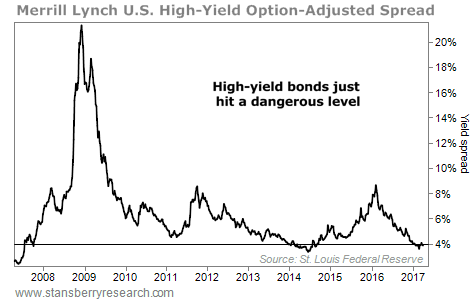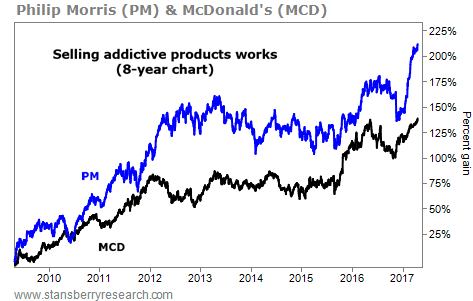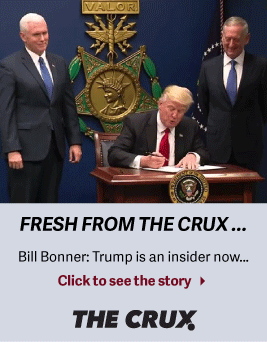| Home | About Us | Resources | Archive | Free Reports | Market Window |
A Crash Is Coming in High-Yield BondsBy
Thursday, April 20, 2017
If you're a junk-bond investor, I have a message for you.
Get out.
The easy money in high-yield bonds is gone. Prices have soared. And the overall high-yield bond market sits at dangerous levels today.
History says this setup could lead to double-digit losses. And that's why the smart move is to get out – now.
Let me explain...
High-yield bonds have soared over the past 14 months. The iShares iBoxx High Yield Corporate Bond Fund (HYG) is up 16% from its February 2016 bottom.
HYG is still near its recent highs. It hasn't begun to break down yet. But buying today is incredibly dangerous. That's because right now, you're getting almost zero premium for the risk you're taking in high-yield bonds.
You see, high-yield, or "junk" bonds, come from companies with questionable prospects. They're less-than-stellar businesses... And they have to pay higher interest rates because of that extra risk.
In exchange for taking on more risk, investors are supposed to get the benefit of higher yields... But right now, that benefit hardly exists. High-yield bonds pay less than 6% today. That's one of the lowest yields we've seen over the last decade.
This makes owning junk bonds a scary idea. But the overall yield isn't even the best way to see what's happening. You can do better by looking at the junk bond "spread."
By "spread," I mean the difference between the yield on high-yield bonds and the yield on similar-duration government bonds. For example, if high-yield bonds pay 6% and government bonds pay 2%, then the spread is 4%.
A high spread means high-yield bonds are a good deal. You'll earn a lot of income to compensate for the extra risk. But a low spread means high-yield bonds are a bad value – and much riskier.
High-yield bond spreads recently hit a multiyear low. Take a look...
 The current spread is at a level we've only seen a few other times in the past decade. And those were dangerous times to put money to work in high-yield bonds. Spreads were below 4% in mid-2007. That was just before the "Great Recession," which kicked off a massive 30%-plus decline in the high-yield market.
We saw spreads bottom below 4% in 2014 as well. And high-yield bonds went on to fall by roughly 20% in the next year and a half.
Today, spreads are low again... at just 4.1%, as I write. And they've been below 4% for most of 2017.
This is a dangerous warning sign for high-yield bond investors. There's simply no margin for error with yields this low. And history says that major busts tend to begin when the spread hits current levels.
I can't know the exact timing... But even if I'm early, the message is correct.
If you own high-yield bonds, get out – now.
Good investing,
Brett Eversole
Further Reading:
If you're looking to generate income, Steve Sjuggerud has found a way to make 9% a year in "virtual banks." Find out why he calls it "the highest-yielding, safest investment out there today" right here.
It's possible to generate double-digit annual returns a year in the market without ever buying stocks or bonds. It sounds too good to be true, but as income expert Dave Eifrig explains, it's not. Learn more here: How Retirees Can Make 15%-20% Yields... Right Now.
Market NotesAN UNPOPULAR BUT PROFITABLE STRATEGY Today, we revisit the idea of "investing in vice"...
Longtime DailyWealth readers know we've highlighted the power of investing in companies that sell habit-forming (or even addictive) products, like soda, coffee, and alcohol. People buy these products, drink them, then go out and buy more. Most companies who sell addictive products enjoy the benefit of repeat customers.
For proof, we'll look to two other addictive products – cigarettes and fast food. Phillip Morris (PM) is a $178 billion tobacco giant. The company owns popular cigarette brands Marlboro, Benson & Hedges, and Parliament. McDonald's (MCD) needs little introduction. The $108 billion fast-food behemoth sold $25 billion worth of its popular burgers and fries last year alone.
In the chart below, you can see the steady uptrends in PM and MCD shares. Shares are up around 210% and 145%, respectively, over the last eight years, and both are trading at new all-time highs. It may not be popular, but buying companies that sell addictive products continues to be an excellent long-term investment strategy...
 |
Recent Articles
|



